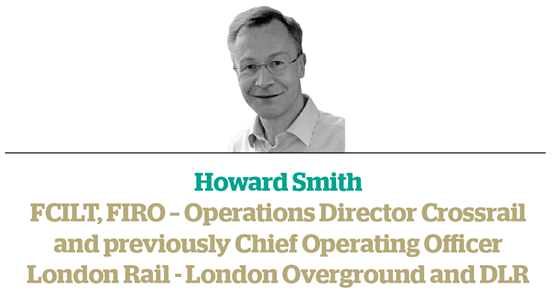
Richard George makes a sound case for continued investment in rail, and specifically infrastructure, and that autonomous vehicles are some way into the future. While he will probably be proved right - that mass transport by rail is the only feasible means to move large volumes of people around congested cities and for speedy medium-distance journeys - there are reasons to question whether we need to recalibrate some of our assumptions.
First, we are not innovating fast enough, and are potentially implementing solutions that are already out of date. Second, employment and travel patterns are changing. Third, we are not doing enough to successfully integrate transport modes - all of which could contribute to significant changes in demand for rail transport.
Train control systems over the past two centuries have evolved from ‘Bobbies’ walking in front of engines with flags on sticks, to time interval working, to Absolute Block with mechanical signals on posts, to colour light Track Circuit Block - all of which limit capacity to fixed lengths of track. New traffic management control systems can potentially increase capacity, as a train can proceed providing a proximity gap is maintained with the train ahead.
The problem is buying the right technical solution that is affordable. This is likely to mean replacing kit as it becomes due for renewal and overlaying it on existing block signalling, thereby missing out on the benefit of providing more capacity. Failure to provide the necessary capacity and address chronic overcrowding at certain times will cause the public to rethink ways of doing business and avoid rail travel.
For the past decade or more passenger growth has comfortably outperformed forecasts as employment in large towns and cities, particularly in London and the South East, has continued to grow and as services on rural routes have been stepped up to make leisure journeys feasible once more.
However, despite the relatively positive economic conditions, the rail industry’s revenue growth has started to stall - particularly season ticket revenue. Regular commuters will be acutely aware of the difficulty in obtaining a seat or car park space early in the week, and the relative ease towards the end of the week. Commuters once tied to their office computer now find that with modern laptops and tablets, and with the advent of businesses switching to cloud computing, it is quite acceptable to work more flexibly - at home. Businesses have encouraged this approach by downsizing office accommodation to cut rental costs and by encouraging staff to use their own accommodation, by providing a limited number of ‘shared work zones’. The consequence of this is that while overall employment continues to grow the extent of travel growth is slowing. It is difficult to foresee how this change in travel patterns might be reversed.
Through their franchise agreements, train operators are encouraged to work with other transport providers to integrate rail with other transport modes, but this is rudimentary at best. Connections with cycle banks, trams, buses and taxis needs a step-change for many to be convinced that the end-to-end journey is a better deal than taking a car, and so a complete change in mindset about the role of rail as part of the overall journey is required if we are to keep current customers and win new ones to rail.
I agree that investing in rail infrastructure is the best mass transport solution, but significant rethinking about our approach is required for this to deliver a successful outcome.

Richard’s excellent article touches on two key points: firstly, that technology is intermediated through economic, geographical and legal factors; and secondly, that new technologies rarely (if ever) sweep away entirely those that preceded them. In an international railway benchmarking group, we marvelled that while we have real-time train locations on Google and city maps, we also tweet, email and phone customers, and still post up and distribute timetables in time-honoured fashion.
The car, autonomous or not, still has the physical constraints that Richard details. Even with closer separation and zero emissions (at point of use), it’s not an efficient point-to-point people mover to match the 1,500 people in a modern commuter train.
Worldwide, a key driver of growth in rail has been the move not only from country to town, but also bigger and denser urban areas of the kind best suited to rail. The trend in urbanisation is set to continue, and the same ‘shared use’ dynamic that moves millennials from the Mondeo parked outside to shared vehicles (autonomous or otherwise), and to mobility as a service, may also make them more ready to embrace a lifestyle based largely on city living and public transport.
Railway systems and technologies adapt. The old radial routes are being joined by dedicated high speed, and by innovations such as the Docklands Light Railway (with its smaller trains, but viable with the more efficient operating model that automation and early CCTV allowed) and London Overground (a seven-day orbital service that links the city in a way that simply wasn’t possible before).
That’s not to suggest that autonomous vehicles do not have a very significant role to play in the future of transport, just that it will be different and possibly focused (at least in the first decade or two) on those economic and geographical areas - motorways, new towns and suburbs, freight movements rather than passenger - where the benefits are most easily realised.
Finally, let’s think about something that is, to me, a conundrum. We often see this debate in terms of new technology (in the form of autonomous vehicles) replacing trains. Isn’t the much smaller leap of imagination to envisage the same technologies used to make huge strides in terms of train control - as well as other attributes of the digital world?
The DLR and Vancouver’s Skytrain were revolutionary at the time, but used computing power that can these days be found in a dishwasher. Trains offer easy answers to the most challenging constraints on autonomous vehicles: a consistent and predictable infrastructure; a common set of rules; an overall system architect; clear legal accountabilities. So should we also ask what’s stopping a much more rapid development of the Digital Railway, or railways?
In the UK our current organisational model, with track authorities, operators, lessors, contractors and myriad others, has brought passenger growth and a keen focus on utilising every bit of spare capacity. But this makes it incredibly difficult to take a joined-up view when it comes to projects, especially those such as digital that bring long-term good, but with short term costs and impacts. At TfL we have tried to simplify this through a different model but in the meantime, Google Rail anyone...?











